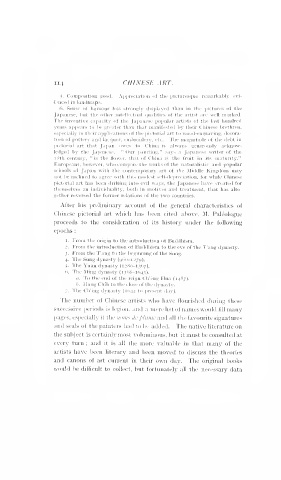Page 368 - Chinese Art, Vol II By Stephen W. Bushell
P. 368
:
114 CHINESE ART.
5. Composition good. Appreciation of the picturesque remarkably evi-
(1 ?nced in landscape.
6. Sense of fiumour less strongly displayed than in the pictures of the
Japanese, but the other intellectual qualities of the artist are well marked-
The inventive capacity of the Japanese popular artists of the last hundred
years appears to be greater than that manifested by their Chinese brethren,
especially in their applications of the pictorial art to wood-engraving, decora-
tion of pottery and lacquer, embroidery, etc. The magnitude of the debt in
pictorial art that Japan owes to China is always generously acknow-
ledged by the Japanese. " Our painting," says a Japanese writer of the
1 8th century, "is the flower, that of China is the fruit in its maturity."
Europeans, however, who compare the works of the naturalistic and popular
schools of Japan with the contemporary art of the Middle Kingdom may
not be inclined to agree with this modest self-depreciation, for while Chinese
pictorial art has been drifting into evil ways, the Japanese have created for
themselves an individuality, both in motives and treatment, that has alto
gether reversed the former relations of the two countries.
After his preliminary account of the general characteristics of
Chinese pictorial art which has been cited above, M. Paleologue
proceeds to the consideration of its history under the following
epochs
1. From the origin to the introduction of Buddhism.
2. From the introduction of Buddhism to the eve of the T'ang dynasty.
3. From the T'ang to the beginning of the Sung.
4. The Sung dynasty {960-1279).
5. The Yuan dynasty (1280-1367).
6. The Ming dynasty { 1 368-1643).
a. To the end of the reign Ch'i-ng Hua (14S7).
b. Hung Chill to the close of the dynasty.
7. The Ch'ing dynasty (1644 to present day).
The number of Chinese artists who have flourished during these
successive periods is legion, and a mere list of names would fill many
pages, especially if the noms de plume and all the favourite signatures
and seals of the painters had to be added. The native literature on
the subject is certainly most voluminous, but it must be consulted at
every turn ; and it is all the more valuable in that many of the
artists have been literary and been moved to discuss the theories
and canons of art current in their own day. The original books
would be difficult to collect, but fortunately all the necessary data

